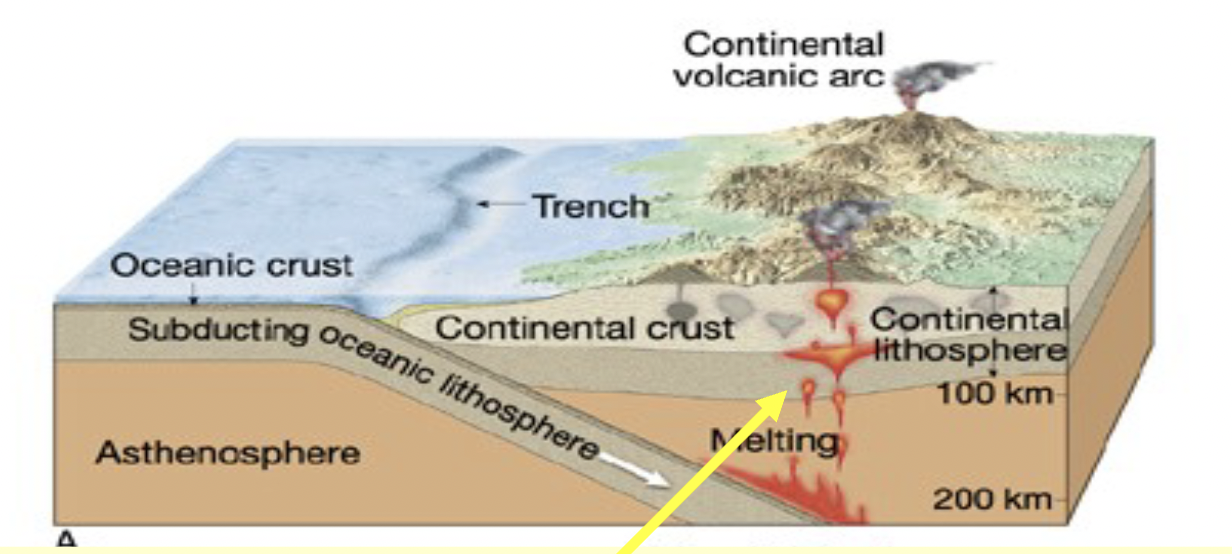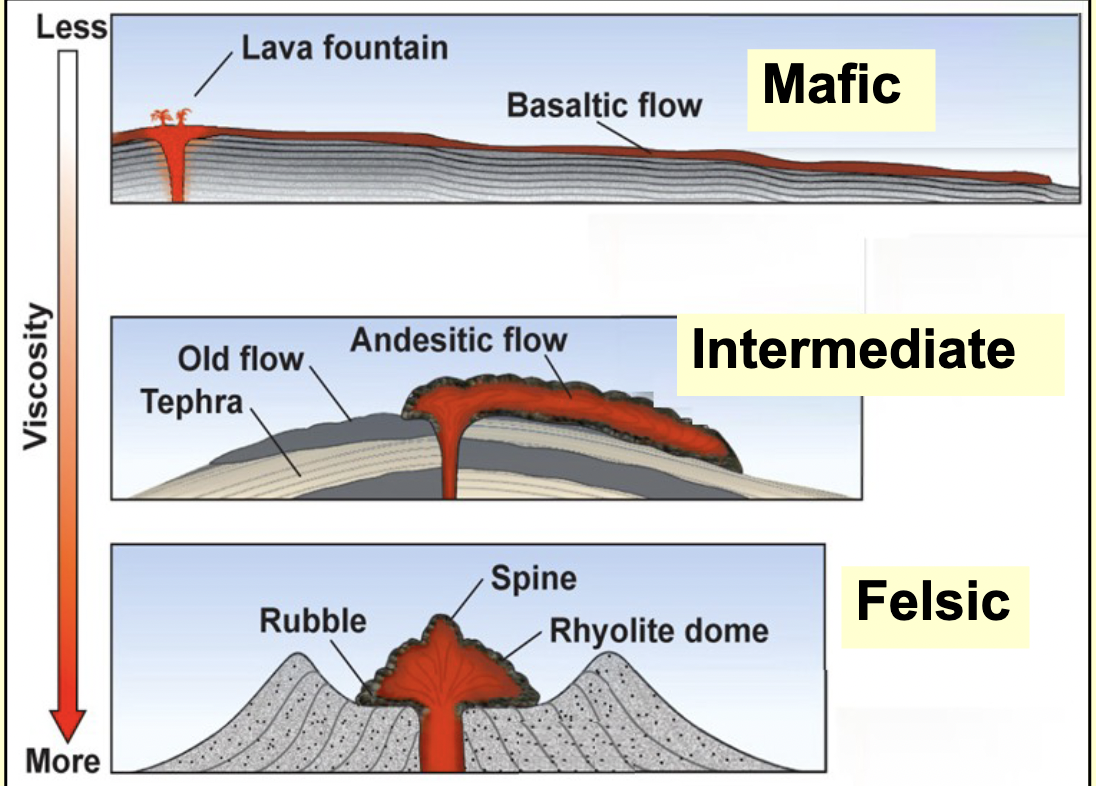
Exam 2 - Geology
Earthquakes and Earthquake Hazards (Chapter 5)
Why do earthquakes occur?
Elastic rebound theory — stress applied to an object transfers energy,q2q2
Strain builds up in rocks
theory based on elastic properties of rocks explains how earthquakes occur
stress causes rocks to deform and change shape or volume
Volcanoes and Volcanic Hazards (Chapter 6)
Volcano - a vent through which molten material surfaces; a mountain formed from solidified eruption material
majority (2/3) of active volcanoes are on the “ring of fire” (mostly convergent plate boundaries)
Magma and Melting
Why do rocks melt? — interior of the Earth is hot
geothermal gradient: the rate of temperature increase in the Earth with increasing depth
as we go deeper into the earth, it gets hotter
Solid (crystal shape, internal arrangement) — pressure tends to hold crystal shape together
Liquid — increasing temp during burial can break bonds causing solid to melt
adding water lowers melting temperature of rocks
makes it easier to melt, harder to crystallize
Effect of Pressure and Volcanoes

rising molten material does not crystallize beacause of a decrease in ambient pressure
spreading occurs in lithosphere, solid asthenosphere rises to fill the gap and melts as it rises
most volcanoes happen in divergent and convergent boundaries

Magma compositions vary in content of silicia, iron, magnesium, and gases
Magmas contain gas bubbles that expand as the magma rises (lower pressure)
the type of lava (mafic, felsic, and intermediate) affects lava characteristics (viscosity)
viscosity: resistance to flow
high viscosity = poor flow
MAFIC:
low in silica (45-50%) but high in iron and magnesium
low viscosity - flow easily
easy for gas bubbles to escape — gentle eruptions
FELSIC:
high in silicia (up to 75%) but low in iron and magnesium
high viscosity - doesn’t flow well
hard for gas bubbles to escape — explosive eruptions
INTERMEDIATE:
mid range of silica (50-65%), iron, and magnesium
Types of Volcanoes
fissure eruptions — magma escapes from a large crack in the lithosphere instead of an individual chimney or vent
individual volcanoes
shield volcanoes — shield like shape; gentle slop; many thin basalt (low viscosity) flows; ex. Hawaiian islands, Mauna Loa; ‘gentle slope’ does NOT mean small (actually the biggest)!
lava domes — mound-shaped structure; formed from high-viscosity lava when there is low gas pressure; lava can’t flow far; piles up around the vent; erupt explosively with high enough gas pressure
cinder cones — minor explosive volcano; central part of cone is filled with a blob of solidified/congealed lava; when pressure builds up it explodes, moves as pyroclastic; size of pyroclastic vary; pyroclastic fall close to the vent creating a cone-shaped volcano
fragmental material ejected from a volcano
solidified lava in a variety of sizes
Ash: powdery glass shards
Lapilli: pea-plum sized material
Blocks and Bombs: apple to refrigerator size
blocks: pre-existing rock torn from volcano; irregular, angular shapes
bombs: streamlined fragments of ejected lava
composite volcanoes — aka stratovolcanoes; build up of layers of lava and pyroclastic; mix of lavas and pyroclastic layers allows a tall volcano to form; usually associated with subduction zones; tend to be violent and explosive (Ex. Mount St. Helens)
Three Forms of Volcanic Eruptions
Lava Flows: molten rock flows over the ground
Pyroclastic debris: fragments blown out of a volcano
Volcanic gases: vapor and aerosols that exit a volcano; mostly water vapor and carbon dioxide
Volcanic Hazards
Lava Flows - immovable objects: high risk; people: low risk
lava moves slowly; usually only “spectators” are harmed
Pyroclastic Debris
tephra: ash and lapilli fall around the volcano
Blasts
Pyroclastic Flows
Volcanic Gasses
Volcanic Aerosols
Waves and Tsunamis (Chapter 9)
Tsunami causes:
earthquakes
volcanic eruptions
landslides
impacts
All coastal areas are at risk, but areas close to major subduction zones or directly across an ocean from them are at the most risk
Exam 2 - Geology
Earthquakes and Earthquake Hazards (Chapter 5)
Why do earthquakes occur?
Elastic rebound theory — stress applied to an object transfers energy,q2q2
Strain builds up in rocks
theory based on elastic properties of rocks explains how earthquakes occur
stress causes rocks to deform and change shape or volume
Volcanoes and Volcanic Hazards (Chapter 6)
Volcano - a vent through which molten material surfaces; a mountain formed from solidified eruption material
majority (2/3) of active volcanoes are on the “ring of fire” (mostly convergent plate boundaries)
Magma and Melting
Why do rocks melt? — interior of the Earth is hot
geothermal gradient: the rate of temperature increase in the Earth with increasing depth
as we go deeper into the earth, it gets hotter
Solid (crystal shape, internal arrangement) — pressure tends to hold crystal shape together
Liquid — increasing temp during burial can break bonds causing solid to melt
adding water lowers melting temperature of rocks
makes it easier to melt, harder to crystallize
Effect of Pressure and Volcanoes

rising molten material does not crystallize beacause of a decrease in ambient pressure
spreading occurs in lithosphere, solid asthenosphere rises to fill the gap and melts as it rises
most volcanoes happen in divergent and convergent boundaries

Magma compositions vary in content of silicia, iron, magnesium, and gases
Magmas contain gas bubbles that expand as the magma rises (lower pressure)
the type of lava (mafic, felsic, and intermediate) affects lava characteristics (viscosity)
viscosity: resistance to flow
high viscosity = poor flow
MAFIC:
low in silica (45-50%) but high in iron and magnesium
low viscosity - flow easily
easy for gas bubbles to escape — gentle eruptions
FELSIC:
high in silicia (up to 75%) but low in iron and magnesium
high viscosity - doesn’t flow well
hard for gas bubbles to escape — explosive eruptions
INTERMEDIATE:
mid range of silica (50-65%), iron, and magnesium
Types of Volcanoes
fissure eruptions — magma escapes from a large crack in the lithosphere instead of an individual chimney or vent
individual volcanoes
shield volcanoes — shield like shape; gentle slop; many thin basalt (low viscosity) flows; ex. Hawaiian islands, Mauna Loa; ‘gentle slope’ does NOT mean small (actually the biggest)!
lava domes — mound-shaped structure; formed from high-viscosity lava when there is low gas pressure; lava can’t flow far; piles up around the vent; erupt explosively with high enough gas pressure
cinder cones — minor explosive volcano; central part of cone is filled with a blob of solidified/congealed lava; when pressure builds up it explodes, moves as pyroclastic; size of pyroclastic vary; pyroclastic fall close to the vent creating a cone-shaped volcano
fragmental material ejected from a volcano
solidified lava in a variety of sizes
Ash: powdery glass shards
Lapilli: pea-plum sized material
Blocks and Bombs: apple to refrigerator size
blocks: pre-existing rock torn from volcano; irregular, angular shapes
bombs: streamlined fragments of ejected lava
composite volcanoes — aka stratovolcanoes; build up of layers of lava and pyroclastic; mix of lavas and pyroclastic layers allows a tall volcano to form; usually associated with subduction zones; tend to be violent and explosive (Ex. Mount St. Helens)
Three Forms of Volcanic Eruptions
Lava Flows: molten rock flows over the ground
Pyroclastic debris: fragments blown out of a volcano
Volcanic gases: vapor and aerosols that exit a volcano; mostly water vapor and carbon dioxide
Volcanic Hazards
Lava Flows - immovable objects: high risk; people: low risk
lava moves slowly; usually only “spectators” are harmed
Pyroclastic Debris
tephra: ash and lapilli fall around the volcano
Blasts
Pyroclastic Flows
Volcanic Gasses
Volcanic Aerosols
Waves and Tsunamis (Chapter 9)
Tsunami causes:
earthquakes
volcanic eruptions
landslides
impacts
All coastal areas are at risk, but areas close to major subduction zones or directly across an ocean from them are at the most risk
 Knowt
Knowt